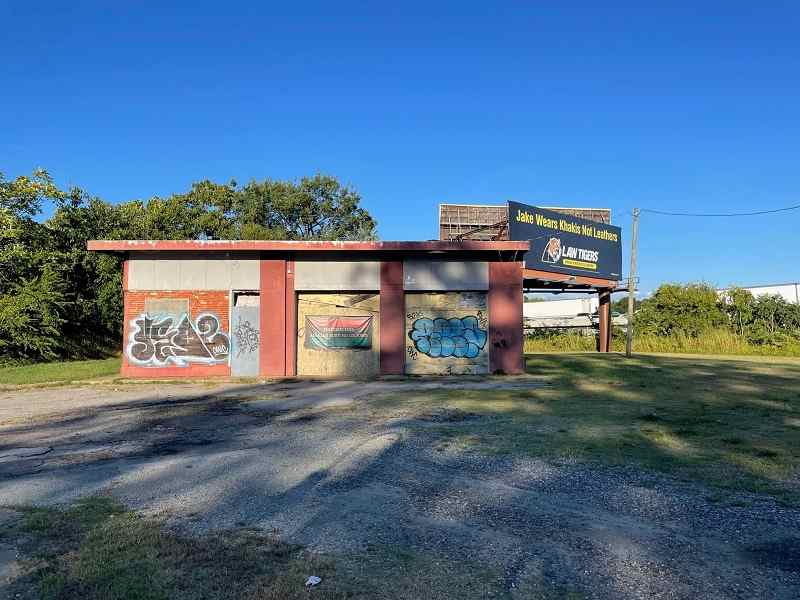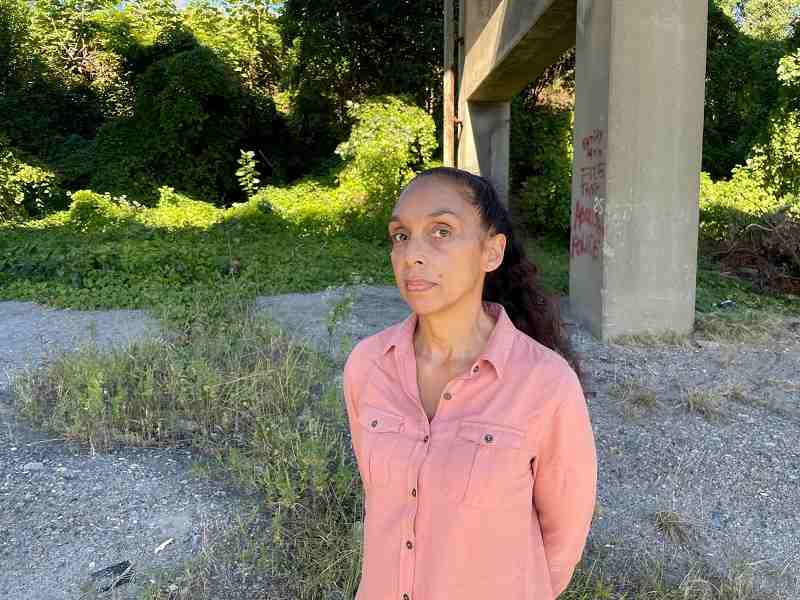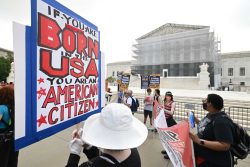
The site of the long-forgotten Shockoe Hill African Burying Ground in Richmond on Sept. 13.
14:06 JST, October 29, 2022
RICHMOND – Lenora McQueen’s fourth-great-grandmother was enslaved at a plantation outside Charlottesville and moved to Richmond near the end of her life. Then she disappeared.

Lenora McQueen stands beneath an I-64 overpass in Richmond on Sept. 27, 2022, at the Shockoe Hill African Burying Ground, which operated from 1816 until the 1870s.
McQueen, working from her home in Texas, set out to solve the mystery of her ancestor’s final resting place. In the process she opened a window into the lives – and deaths – of thousands of other people whose stories city leaders had tried to obliterate.
Richmond’s long-forgotten Shockoe Hill African Burying Ground, which McQueen brought to light, is adjacent to two well-preserved cemeteries for White people, including former U.S. Supreme Court chief justice John Marshall and Confederate veterans. But the African burying ground is invisible beneath an abandoned gas station, highway overpasses and railroad tracks.
“Nobody could see it,” said Ana Edwards, an activist who has spent years elevating Richmond’s Black history. “It was simply shoveled under roadways and scraped aside to make room for bridges. There was no respect. That really hurts, but there’s also anger.”
Historians now believe Shockoe Hill could be the largest cemetery for free and enslaved Africans in the country, eclipsing New York City’s African Burial Ground National Monument.
McQueen set a precedent this summer by working with experts to get the Shockoe Hill burying ground onto the National Register of Historic Places. It was honored not only for a history dating to 1816 but for the systematic effort to erase Black heritage that took place there – opening the door for other desecrated landmarks to be recognized.
But the threats continue. Plans for a new Richmond-to-D.C. rail line are set to further damage the burying ground. McQueen and other advocates are scrambling to push the Federal Railroad Administration to slow the process and reroute the tracks.
“So many things have been done to this, but it’s still a burial ground,” McQueen said on a recent visit to Richmond. She walked along Hospital Street, cut through the cemetery more than a century ago. Cars thunked across the Interstate 64 bridges overhead; candy wrappers, beer cans and plastic foam food containers littered the weeds along the sidewalk.
“I just remember seeing this for the first time and thinking I must be in the wrong place,” she said. “But I wasn’t.”
McQueen’s work suggests the breadth of history underfoot in a place such as Richmond, an old city that had long kept a jealous focus on Confederate statues and monuments.
But it also shows the power of the simplest of personal stories. Because McQueen, an amateur historian driven by uncommon perseverance, has cracked open the past with only a few fragile tools.
First she had a name.
Then a letter.
And then a poem.
– – –
McQueen, a teacher originally from New Jersey, got interested in genealogy through a cousin in Charlottesville. It was supposed to be a quiet hobby. She is an extremely private person – don’t try asking her age – but had long been curious when relatives told tales of being connected to Thomas Jefferson and Monticello.
While that hasn’t been confirmed, the cousin connected McQueen with a local genealogist who found links to another nearby plantation called Morven. Slowly, McQueen’s reserve was overtaken by a compulsion to research and investigate.
In 2001, billionaire John Kluge donated nearly 7,400 acres, including Morven Farm, to the University of Virginia. When he died in 2009, the news prodded McQueen to call the university and ask if anyone had been researching the plantation’s enslaved community. She wound up talking with history professor Scot French.
McQueen is a persistent emailer and phone caller, and she and French quickly formed a long-distance partnership. She helped mentor a small group of students in their research about Morven, French said in an interview, guiding them as a descendant and compiling a database of all their findings.
“She isn’t an academic, but she really brings an academic’s rigor to the research that she does,” said French, who now teaches at the University of Central Florida but this year resumed a special course at Morven with McQueen. “She’s moved in a really powerful way by the need to do this kind of work.”
His students located an inventory of property from the will of early Morven owner David Higginbotham, who died in 1853; it named 56 enslaved people. French thought the list was of limited value – it gave only first names.
But McQueen’s eye caught something the class had missed: the name Kitty Cary. The students had taken that as a double name, like Mary Sue, but McQueen recognized Cary as a surname in her family history. Other documents established that she was McQueen’s fourth-great-grandmother.
“Maybe that’s the reason I feel especially connected to her,” McQueen said, “because she was my discovery.”
Time teased out small details of Cary’s life. She was born in the 1790s. She had several children and belonged to a church. The Higginbotham daughters referred to her affectionately in letters – she might have been involved in raising them, possibly lived with them in the main house. One document indicated that when David Higginbotham died, Cary was paid to help compile the inventory – apparently the only enslaved person given such a job.
After Higginbotham’s death, the family sold the farm and auctioned off the enslaved workers. His wife moved away. As of 2010, that was all McQueen could learn.
“I was left with a cliffhanger,” McQueen said, “except that the owner’s widow indicated to her daughter that she would keep Kitty.”
Further research showed that the widow relocated to Richmond. “I knew . . . I needed to go to Richmond to try to find her,” McQueen said.
It took her seven years.
– – –
In 2017, McQueen was invited to U-Va. for a conference on descendants of the enslaved.
Arriving early, she drove to offices of the Virginia Historical Society in Richmond to see the Higginbotham family papers. It was a mountain of material. But as she picked up one document, a word jumped out at her: Kitty.
Elizabeth Higginbotham Fisher, daughter of the plantation’s late owner, was writing from Richmond in 1857 to her sister in Philadelphia about her grief over Cary’s death.
“It was a very beautiful letter. It made me cry,” said McQueen, who speaks quietly and betrays little emotion in public.
“Our dear, faithful, old Kitty is [no] more,” Elizabeth Fisher wrote, according to McQueen’s transcription of the letter.
Just after 5 that morning, the letter said, word had come that Cary was dying. Fisher ran downstairs only partly dressed. Cary’s children gathered bedside as she said her final words, “Don’t cry children, don’t cry for me, I am going home.”
The scene “has so completely unhinged me that I am unfit for any thing,” Fisher wrote. “I staid there and had her neatly prepared for the tomb – it was what she would have done for me.” She added that “I intend following her body to the grave tomorrow afternoon.”
Here was a raw glimpse of the complicated racial relationships of the day, and a far more intimate connection to her ancestor than McQueen had dared hope to find. It also provided a clue: Cary’s final resting place was near the family’s downtown home.
McQueen’s elation took an ugly turn the next day. One of the topics at her U-Va. symposium was the practice of grave-robbing that plagued Richmond during the 1800s. So-called resurrectionists dug up corpses for dissection in the medical schools in Richmond and Charlottesville – mainly from Black burial grounds.
“It was an awful, horrifying feeling,” McQueen said, to think that her ancestor might have been violated.
Richmond’s most well-known African burying ground was downtown, near the South’s second-busiest slave market after New Orleans. Paved over and partly destroyed by the highway in the 1950s, that site is now covered with grass and set aside as a place for reflection. For nearly two decades, the Sacred Ground Historical Reclamation Project – led by Edwards – has been urging the city to do more to commemorate it.
When Cary died in 1857, though, that cemetery was closed. McQueen’s research showed that the city established three new burying grounds along its northern boundary in 1816 – one for White Christians, one for Jews and another for Black people, free and enslaved.
The third one had to be the place. Before visiting it, McQueen stopped at Fisher’s grave in Richmond’s marquee burial ground, Hollywood Cemetery, established slightly later than the ones she had been researching.
The Higginbotham and Fisher headstones stand in a clearing atop a hill surrounded by magnolia and holly trees. McQueen marveled at the setting – the James River far below, couples and schoolchildren strolling past elaborate grave markers telling of so many lives.
The next day she went to find Kitty Cary’s cemetery. She drove down the hill beneath the highway to railroad tracks and a sewage-treatment plant. She drove back up. Nothing but an abandoned gas station and a low concrete building. She drove back down.
Finally, it dawned on her: This was it. This was the African burying ground.
Fueled by a sense of outrage, McQueen decided to investigate. She researched old deeds, maps and news clippings and discovered that the burying ground had grown to 31 acres before being shut down in 1879. City records suggested at least 22,000 burials. New York’s African burial ground is thought to contain remains of about 15,000 people.
Beginning in the Reconstruction era, the Richmond burying ground was systematically erased – first from view, then from memory. Road workers dug up graves in the 1880s and, despite warnings from the city council, used the bones as fill material, according to contemporary news accounts found by McQueen and archaeologist Steve Thompson.
A few years later, the top of the burying ground was regraded for construction of a bridge, exposing more graves. Black newspaper publisher John Mitchell Jr. mourned “the hearts of the surviving families made to bleed by the desecration of the remains of their loved ones.”
Railroads carved through the bottom of the hill around 1900, and by the 1960s the highway and a gas station had obliterated any lingering hint of the site’s former use. A 2013 Virginia Department of Transportation report on widening that section of highway suggested no historical resources would be damaged by the project.
Working from Texas and overcoming a fear of the limelight, McQueen has marshaled an army of supporters to fight back. She helped the D.C.-based Cultural Landscape Foundation make a video about the site.
In 2018, McQueen discovered that the now-abandoned gas station was on a list of tax delinquent properties to be sold at auction. She hounded the city of Richmond to buy it (which it did, for $160,000), whipped up a campaign for a state historical marker and worked with historians to seek National Historic status.
“In the history of this department, in all the properties we have listed, we have never had a single nomination [for a historical marker] receive so many letters of support,” said Julie Langan, director of the Virginia Department of Historic Resources.
The campaign for national status was the longest shot. The National Register usually judges sites on how intact or undisturbed they are. In this case, the application argued that the African burying ground deserved to be included in part because Richmond has systematically obliterated it over the past 140 years – signifying a different type of history.
Its successful listing will “certainly open up the possibility of putting many more African American cemeteries on the registry,” said Michael Blakey, a professor at the College of William and Mary who did trailblazing work on the New York burial site.
The designation has also helped McQueen and other supporters slow the process for approving construction of a new high-speed train route between Richmond and D.C., which is set to cut one more scar across the bones of people’s ancestors.
The Federal Railroad Administration “fully recognizes the cultural and historical importance of the Shockoe Hill African Burying Grounds,” a spokesman for the agency said via email, adding that regulators will work with stakeholders in a review process that could take years.
– – –
Despite all of the destruction, elements of the cemetery remain. A recent preliminary survey with ground-penetrating radar found evidence of multiple graves, said Kimberly Chen of the Richmond planning office.
Even more remarkable are the cultural traces. Historian Ryan K. Smith of Virginia Commonwealth University, who maintains a web site on Richmond cemeteries, points to a powerful scene in the works of Frederick Law Olmsted – the famous landscape architect who traveled the South before the Civil War to observe slavery.
Olmsted writes of visiting Richmond in 1853 and coming upon a “negro funeral.” His description fits the Shockoe Hill African Burying Ground – a “desolate place” just beyond the city’s principal cemetery, which by contrast is “well filled with monuments and evergreens.”
About 50 Black mourners follow a horse-drawn hearse, with six coaches and six “well-dressed men” on horseback. They stop near the fresh grave of a child; another grave is open beside it.
Olmsted struggles to understand what to him is an unfamiliar scene. One speaker stands at the head of the open grave and holds a handkerchief like an open book, “as if he were reading from it,” proclaiming lines of scripture punctuated by howls of grief. Another man leads a call-and-response hymn, the music “wild and barbarous, but not without a plaintive melody.” Olmsted finds himself “deeply influenced . . . by the unaffected feeling.”
In the end, someone returns from the ravine with two beech branches to mark the grave. As mourners disperse, a lone White man leans against a fence – a policeman, Olmsted presumes, required by law to oversee any gathering of the enslaved.
McQueen would like to see that description serve as the basis for a memorial – maybe a bas-relief sculpture to suggest the vanished heritage of the site.
Visiting the burying ground fills her with “profound sadness,” she says. As she walks from the abandoned garage to the neatly kept Hebrew Cemetery, McQueen says she thinks of her fourth-great-grandmother all the time. She’s horrified at the idea that her body might have been stolen by resurrectionists or ground up in a roadway.
“I don’t know where she is,” she says, but then points over to the next corner. “Except that I think she’s probably over there.”
It’s a startling claim. How can she say that? “Because of the poem,” McQueen says.
Not long ago, a simple Google search turned up a poem published in 1886 by Elizabeth Akers Allen titled “Kitty Cary.” McQueen thought it must be a coincidence because of the late date and because Allen was from faraway Maine. But then she researched.
It turned out that Allen initially published the poem under a pseudonym in Harper’s Weekly in 1866. She had moved to Richmond at the end of the Civil War to help care for Union troops, working at an alms house converted to a hospital. The building still stands, in sight of the burying ground.
“No marble tells where Kitty Cary sleeps – / Only a simple slab of painted pine,” the poem begins. The marker is “So near the highway, that the yellow sand / From passing wheels falls thickly on her grave.” Cattle and goats graze the weeds atop her grave; children run across it “on their way to school.”
To McQueen’s eyes, conditioned by studying old maps, those details are clues. They suggest an actual spot. It’s just possible that out there along Hospital Street – a few feet past its intersection with Fourth Street, where broken glass glitters on a path next to the “passing wheels” of the pavement – the remains of Kitty Cary still lie.
One woman, among so many lost, whose story survives.
"News Services" POPULAR ARTICLE
-

American Playwright Jeremy O. Harris Arrested in Japan on Alleged Drug Smuggling
-

Taiwan President Shows Support for Japan in China Dispute with Sushi Lunch
-

Japan Trying to Revive Wartime Militarism with Its Taiwan Comments, China’s Top Paper Says
-

Japan’s Nikkei Stock Average as JGB Yields, Yen Rise on Rate-Hike Bets
-

Japan’s Nikkei Stock Average Licks Wounds after Selloff Sparked by BOJ Hike Bets (UPDATE 1)
JN ACCESS RANKING
-

Govt Plans to Urge Municipalities to Help Residents Cope with Rising Prices
-

Essential Services Shortage to Hit Japan’s GDP By Up to ¥76 Tril. By 2040
-

Japan Prime Minister Takaichi Vows to Have Country Exit Deflation, Closely Monitor Economic Indicators
-

Japan to Charge Foreigners More for Residence Permits, Looking to Align with Western Countries
-

Japan GDP Down Annualized 1.8% in July-Sept.
























